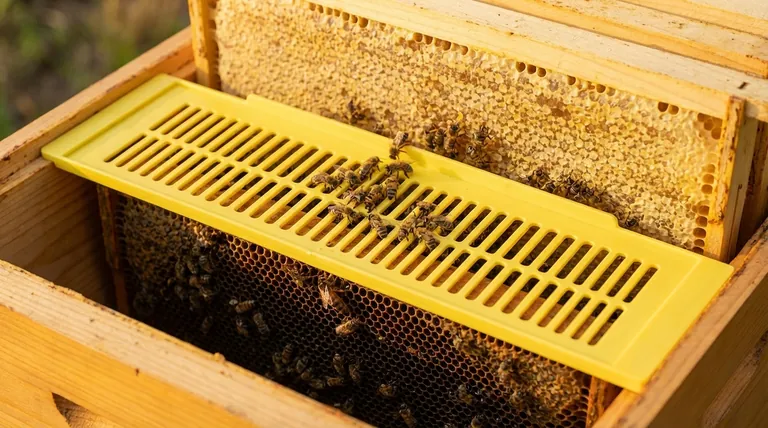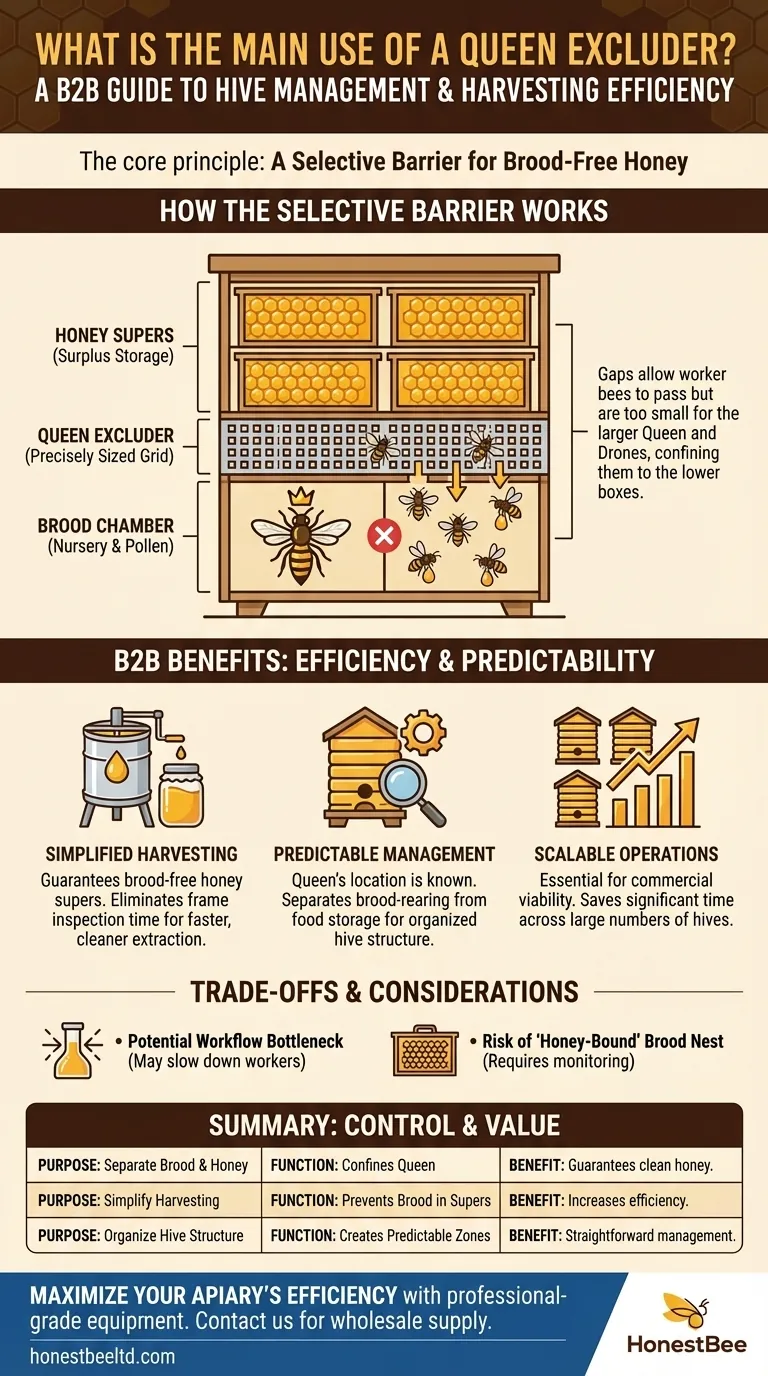At its core, a queen excluder is a selective barrier inside the beehive. Its primary and most critical use is to confine the queen bee to the lower sections of the hive, known as the brood chamber. This ensures she cannot lay eggs in the upper boxes, or "honey supers," reserving them exclusively for honey storage.
The fundamental purpose of a queen excluder is to enforce a clean separation between the hive's nursery (brood nest) and its pantry (honey supers). This simplifies honey harvesting but introduces a physical barrier that can affect the colony's natural workflow.

The Core Principle: A Selective Barrier
A queen excluder operates on a very simple physical principle: size. It is a grid, made of either metal wire or molded plastic, with gaps that are precisely measured.
### How the Barrier Works
The gaps in the excluder are large enough for the smaller worker bees to pass through freely.
However, the gaps are too small for the larger queen bee and the male drones to fit through. This effectively traps them in the boxes below the excluder.
### The "Brood Nest" vs. "Honey Supers"
A beekeeper organizes a hive into distinct zones. The lower boxes are the brood nest, where the queen lays eggs and the colony raises its young. This is also where pollen is typically stored.
The upper boxes, called honey supers, are intended for the storage of surplus honey that the beekeeper will eventually harvest.
### The Goal: Brood-Free Honey
When the queen lays eggs in the honey supers, it creates a significant problem during harvest. Extracting honey from frames that also contain eggs, larvae, and pupae is messy and contaminates the final product.
By using an excluder, the beekeeper guarantees that every frame in the honey super contains only honeycomb, making the extraction process clean and highly efficient.
The Practical Benefits for the Beekeeper
For many beekeepers, especially those in commercial operations, the excluder is a tool for predictability and efficiency.
### Simplified Honey Harvesting
Without an excluder, a beekeeper must carefully inspect every frame of honey to ensure no brood is present before it can be extracted.
An excluder eliminates this step entirely. The beekeeper knows with certainty that any frame above the excluder is safe to harvest.
### Predictable Hive Management
The excluder also simplifies hive inspections. The beekeeper knows the queen will always be located in the brood boxes below the excluder, making her easier to find when necessary.
This containment helps maintain a clear and organized structure within the hive, separating brood-rearing activities from food storage.
Understanding the Trade-offs and Criticisms
Despite its benefits, the queen excluder is a controversial tool, and many successful beekeepers choose not to use one.
### Potential for Reduced Honey Production
The most common criticism is that the barrier, while passable for worker bees, can slow them down. Workers must squeeze through the grid, which can create a bottleneck and discourage them from moving into the honey supers.
This hesitation can lead to a less productive colony and a smaller honey harvest.
### Risk of a "Honey-Bound" Queen
If workers are reluctant to cross the excluder, they may begin to store excess nectar in the brood chamber instead.
This can fill cells that the queen would otherwise use for laying eggs, a condition known as being "honey-bound." This severely restricts the colony's growth and can lead to swarming.
### The "Natural Beekeeping" Perspective
Some beekeepers view the excluder as an unnatural constraint on the colony. They believe it interferes with the bees' natural instinct to move and expand the brood nest as they see fit, creating unnecessary stress.
Making the Right Choice for Your Hive
The decision to use a queen excluder depends entirely on your beekeeping philosophy and goals.
- If your primary focus is maximum harvesting efficiency and perfectly clean honey: An excluder is an invaluable tool that streamlines your workflow.
- If your primary focus is a more natural, hands-off approach: You will likely want to avoid the excluder and instead manage the space in your hive to encourage the queen to lay where you want her to.
- If you manage a large number of hives: The time saved during inspections and harvesting often makes the excluder a necessary component for commercial viability.
Ultimately, the queen excluder is a tool of control, offering the beekeeper predictability in exchange for imposing a restriction on the colony.
Summary Table:
| Purpose | Function | Key Benefit for Beekeeper |
|---|---|---|
| Separate Brood & Honey | Confines the queen to lower hive boxes. | Guarantees brood-free honey supers for clean extraction. |
| Simplify Harvesting | Prevents eggs/larvae in honey storage areas. | Saves inspection time; increases harvesting efficiency. |
| Organize Hive Structure | Creates predictable zones for brood and honey. | Makes hive inspections and management more straightforward. |
Maximize your apiary's efficiency and honey yield with professional-grade equipment from HONESTBEE.
As a trusted wholesale supplier for commercial apiaries and beekeeping equipment distributors, we provide the durable, precision-engineered queen excluders and hive components you need to streamline your operations. Our products are designed to support large-scale, predictable honey production.
Contact our expert team today to discuss your commercial beekeeping supply needs and discover how we can help your business thrive.
Visual Guide

Related Products
- Professional Plastic Queen Excluder for Modern Beekeeping
- Premium Wood Framed Metal Wire Queen Bee Excluder
- High Performance Plastic Queen Excluder for Beekeeping and Apiary Management
- Plastic Queen Bee Excluder for Bee Hive Wholesale
- Wooden Queen Bee Excluder for Beekeeping
People Also Ask
- What are the pros of using queen excluders? Boost Honey Production & Hive Efficiency
- What are the main advantages of using a queen excluder in beekeeping? Simplify Hive Management & Harvest
- How do queen excluders work in terms of spacing and bee movement? A Guide to Precision Hive Management
- What is a Queen Excluder and how does it work? Achieve Purer Honey & Better Hive Control
- What is the primary function of a queen excluder in beekeeping? Control Hive Layout for Efficient Honey Harvesting



















